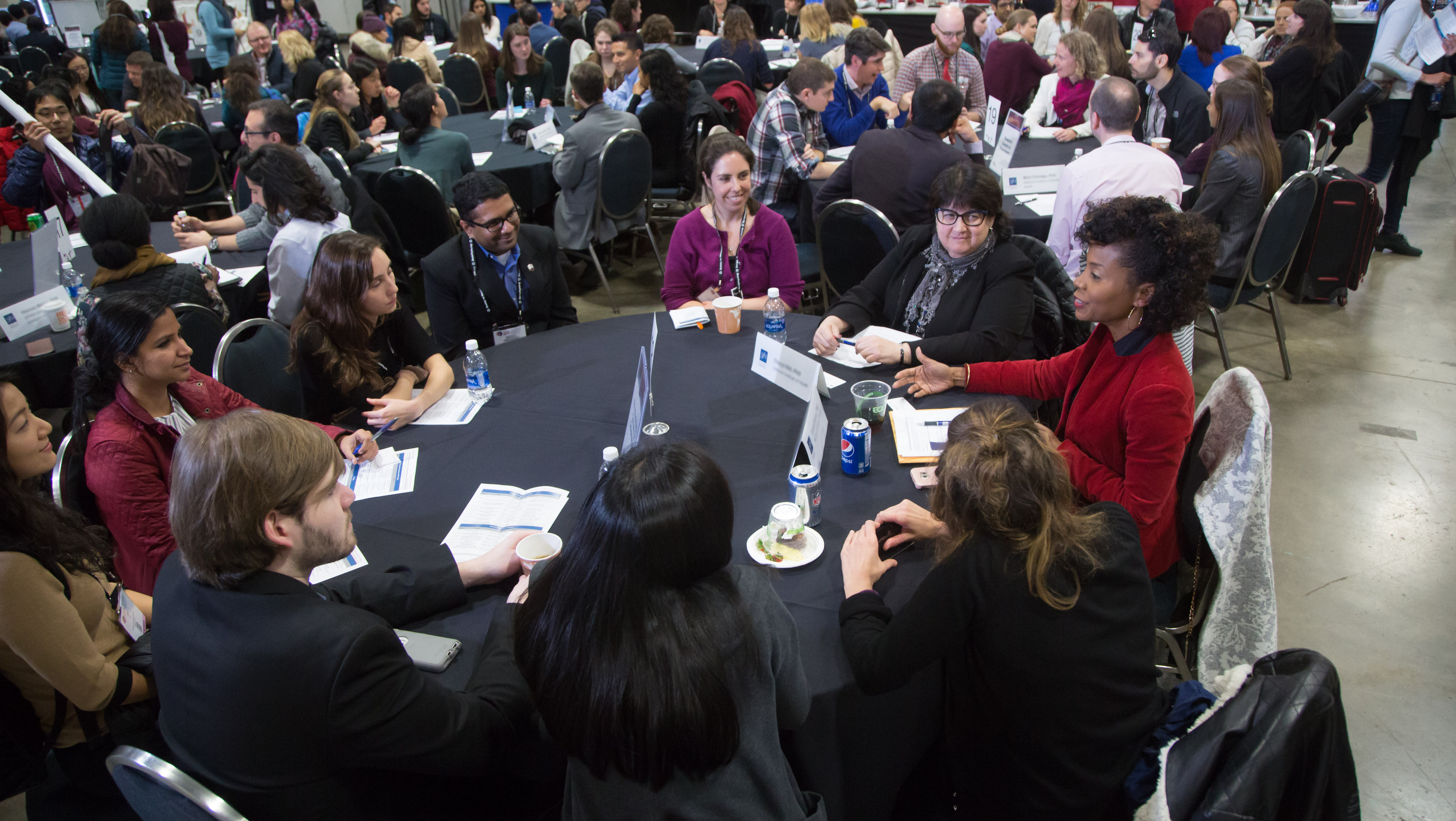
Inside Neuroscience: Neuroprosthetics and Robots Restore Movement, Sight, and Sensation
As a neurologist, Leigh Hochberg, director of the Center for Neurotechnology and Neurorecovery at Massachusetts General Hospital, professor of engineering at Brown University, and director of the VA RR&D Center for Neurorestoration and Neurotechnology, sees “far too often the effects of stroke, traumatic brain injury, neuromuscular failure, spinal cord injury, and a host of other injuries and diseases from the nervous system that can leave people unable to move or unable to communicate.”
Millions of people across the globe have impaired nervous systems that limit their physical abilities, and current therapies and prostheses only help patients to restore partial function in movement, sight, and sensation. During a press conference at Neuroscience 2017 titled “Advances in Neuroprosthestics and Robotics Enrich Lives,” researchers shared how they are combining new and existing technologies to innovate biomedical devices that could improve the lives of those with neurological and psychiatric diseases.
“Their labs’ research at the nexus of neuroengineering, neuroscience, and computer science is not only laying the groundwork for the future of neurotechnologies but by harnessing the powers of the brain and the rest of the nervous system, their research is teaching us more about who we are,” Hochberg said.
“Soft” Robotics
Existing robotics use light or electrical impulses to stimulate movement. In living organisms, however, movement is controlled by neurons, so a robot would need to integrate with neuronal systems in order to be effective for human use.
In contrast to the rigid computer chips, electric motors, and metal joints of which robots are traditionally composed, “soft” robotics are made of malleable, bendable materials similar to those in living organisms, allowing them to be more easily integrated with living tissue and making them less susceptible to environmental changes such as exposure to liquid or radiation.
At the University of Illinois, Urbana-Champaign, researchers cultured a part of a rat’s spinal cord and connected it to a muscle strip to create a so-called “biobot” that contracted when exposed to glutamate, which stimulates muscle contractions, and stopped contracting in the presence of drugs inhibiting muscle movement.
“What I’m proposing is that we have the ability to create these complex motor behaviors by adding a neuronal cell source to this bot,” said Collin Kaufman, a graduate student in Martha Gillette’s group and the lead author of the study. “By putting neurons onto a skeletal muscle scaffold, we’re able to create a neuromuscular junction or essentially a peripheral nervous system in three dimensions in vitro.”
Next, the researchers plan to use the neural circuit to induce more complex muscular behavior. This “neural system on a chip” also has potential to undergo clinical trials and to model neurodegenerative diseases such as multiple sclerosis and ALS.
Controlling Brain-Machine Interfaces
Brain-machine interfaces (BMIs) are increasingly allowing those who can’t move their limbs to partially regain basic motor and communication abilities by using their thoughts — or, at least, the neural activities that accompany the intention to move.
To test whether there is a limit to how much the brain can learn to control a prosthetic device, researchers in Richard Andersen’s group at the California Institute of Technology introduced “perturbations” in the computer program controlled by a clinical trial participant who had learned to control a cursor using a 96-electrode array in her anterior interparietal cortex. By changing the computer’s response to her neural signals, the researchers caused the cursor to malfunction in either a simple or complex way and were able to discern how effectively the subject’s brain compensated for errors due to these changes.
According to Sofia Sakellaridi, a postdoctoral fellow and the lead author of the study, “For the simple perturbation, [the participant] was able to regain control of the cursor after a few trials. For the more challenging perturbations, she wasn’t able to regain control of the cursor.” In the latter case, the results did not improve over time, indicating that the brain can adapt innate activity patterns to compensate for BMI-induced errors but that this form of plasticity is limited.
The study provides researchers with a more developed understanding of the brain’s flexibility as well as insight into which areas of the brain may be ideal for collecting neural activity to control BMIs. The researchers plan to extend the study to other regions of the brain, such as the primary motor and premotor cortices.
Restoring Sensation
In the United States, one in every 200 individuals suffers from the physical impairment, phantom pain, and emotional suffering associated with limb loss. Using a prosthesis in place of a lost limb can help to restore movement and reduce pain, but cannot fully replace the range of sensation that comes with a biological limb, primarily because most prosthetic devices do not provide sensory feedback.
At the University of Utah, however, researchers in the lab of Gregory Clark created a new type of prosthesis that allows movement directed by thoughts and aims to restore somatosensation, or the sense of touch. The researchers fitted an amputee with a prosthetic hand that translated contact force into electrical stimulation of the residual arm nerves. The subject could then feel natural sensations through the prosthetic hand as it made contact with different objects, which further guided his movement.
Lead author Jacob Anthony George said, “We’ve seen that using this prosthetic device causes embodiment, so that the participant actually starts to believe that the prosthetic hand is their own hand.”
The study provides insight into how sensory input influences motor control and how motor actions influence sensory perception. Use of the prosthetic device also led to a 25 percent median reduction in pain, a number that may be increased with long-term daily use. Currently the researchers are working with industry partners to develop a wireless take-home system that will allow subjects to use the prosthetic devices in their natural environments.
An Organic Retinal Prosthesis
One of the most prevalent causes of blindness in humans is the progressive degeneration of photoreceptors typical of Retinitis pigmentosa (RP) and related genetic retinal pathologies. The limited success of drug treatments, gene therapy, or stem cell transplantation in the most severe cases of RP has encouraged many research groups to attempt to restore vision using electrical stimulation of the spared retinal network in degenerative diseases.
The group of Fabio Benfenati at the Italian Institute of Technology in Genoa, Italy, in collaboration with Guglielmo Lanzani and Grazia Pertile, developed an advanced and innovative line of research dealing with the use of organic materials that largely integrate with retinal tissues and improve visual deficits that result from degeneration of photoreceptors. This new artificial retina is a fully organic photovoltaic device that produces an electrical signal when illuminated. It replaces the natural photoreceptors in retinal degenerative diseases
“We demonstrated that our prosthesis implanted in the subretinal space of blind rats promotes the in vivo recovery of normal visual functions by rescuing pupillary light reflex, light-driven behaviors, cortical responses to light stimuli, and visual acuity, to levels comparable to normal animals,” said José Fernando Maya-Vetencourt, the lead author of the study. The improvements were maintained for nearly one year.
A similar photovoltaic device is currently being implanted in pigs with pharmacologically induced visual deficits as the last experimental step before Phase 1 clinical trials. This artificial retina has many advantages with respect to silicon-based prostheses currently in clinical trials, including low heat production, exquisite biocompatibility, no power supply, and intimate tissue connection due to flexibility. The prosthetic holds the potential to challenge existing paradigms of artificial retinas and could provide a promising treatment for human degenerative blindness.
Looking Forward
Each of these interventions aims to provide better and more seamless integration to fill in sensory and motor gaps for humans. Though most of the technologies are still in nascent stages, their potential for impact is enormous. Such engineered solutions have the potential to decrease the burden of living with a causal disorder of the nervous system and to ultimately restore greater functionality. Hochberg said, “This is not only some of the most exciting neuroscience of today, but it’s also the basis for tomorrow’s extraordinary medicine.”























